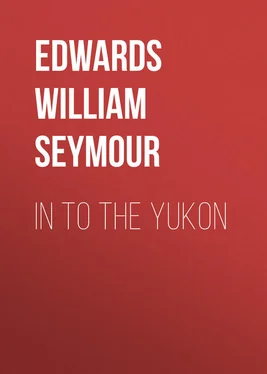William Edwards - In to the Yukon
Здесь есть возможность читать онлайн «William Edwards - In to the Yukon» — ознакомительный отрывок электронной книги совершенно бесплатно, а после прочтения отрывка купить полную версию. В некоторых случаях можно слушать аудио, скачать через торрент в формате fb2 и присутствует краткое содержание. Жанр: foreign_antique, foreign_prose, Путешествия и география, на английском языке. Описание произведения, (предисловие) а так же отзывы посетителей доступны на портале библиотеки ЛибКат.
- Название:In to the Yukon
- Автор:
- Жанр:
- Год:неизвестен
- ISBN:нет данных
- Рейтинг книги:4 / 5. Голосов: 1
-
Избранное:Добавить в избранное
- Отзывы:
-
Ваша оценка:
- 80
- 1
- 2
- 3
- 4
- 5
In to the Yukon: краткое содержание, описание и аннотация
Предлагаем к чтению аннотацию, описание, краткое содержание или предисловие (зависит от того, что написал сам автор книги «In to the Yukon»). Если вы не нашли необходимую информацию о книге — напишите в комментариях, мы постараемся отыскать её.
In to the Yukon — читать онлайн ознакомительный отрывок
Ниже представлен текст книги, разбитый по страницам. Система сохранения места последней прочитанной страницы, позволяет с удобством читать онлайн бесплатно книгу «In to the Yukon», без необходимости каждый раз заново искать на чём Вы остановились. Поставьте закладку, и сможете в любой момент перейти на страницу, на которой закончили чтение.
Интервал:
Закладка:
William Seymour Edwards
In to the Yukon
PREFACE
These letters were not written for publication originally. They were written for the home circle and the few friends who might care to read them. They are the brief narrative of daily journeyings and experiences during a very delightful two months of travel into the far north and along the Pacific slope of our continent. Some of the letters were afterwards published in the daily press. They are now put into this little book and a few of the Kodak snapshots taken are given in half-tone prints.
We were greeted with much friendliness along the way and were the recipients of many courtesies. None showed us greater attention than the able and considerate officials of the Pacific Coast S. S. Co., the Alaska S. S. Co. and the White Pass and Yukon Railway Co., including Mr. Kekewich, managing Director of the London Board, and Mr. Newell, Vice-President of the Company.
At Atlin and Dawson we met and made many friends, and we would here reiterate to them, one and all, our warm appreciation of their hospitalities.
William Seymour Edwards. Charleston-Kanawha, West Virginia, August, 1904.FIRST LETTER
THE GREAT LAKES, CLEVELAND TO DETROIT
We reached Cleveland just in time to catch the big liner, which cast off her cables almost as soon as we were aboard. A vessel of 5,000 tons, a regular sea ship. The boat was packed with well-dressed people, out for a vacation trip, most of them. By and by we began to pass islands, and about 2 P. M. turned into a broad channel between sedgy banks – the Detroit River. Many craft we passed and more overtook, for we were the fastest thing on the lakes as well as the biggest.
Toward 3 P. M., the tall chimneys of the huge salt works and the church spires of the city of Detroit began to come into view. A superb water front, several miles long, and great warehouses and substantial buildings of brick and stone, fit for a vast commerce.
The sail up the Detroit River, through Lake St. Clair, and then up the St. Clair River to Lake Huron, was as lovely a water trip as any I have made. The superb park “Belle Isle,” the pride of Detroit; the many, very many, villas and cottages all along the water-side, hundreds of them; everywhere boats, skiffs, launches, naphtha and steam, all filled with Sunday pleasure excursionists, the many great pleasure excursion steamers loaded down with passengers, gave a life and liveliness to the water views that astonished and pleased us.
The Lake St. Clair is about twenty miles across, apparently broader than it is, for the reason that its sedgy margins are so wide that the trees and higher land further back seem the real border of the lake. What is called the “St. Clair Flats” are the wide, low-lying lands on each side of the long reaches of the St. Clair River. Twenty miles of cottages, hotels, club-houses, are strung along the water-side, each with its little pier and its boats.
Towards dark – eight o’clock – we came to Sarnia and Port Huron, and pointed out into the great lake, second in depth to Superior – larger than any but Superior – a bit of geography I had quite forgotten.
At dawn on Monday, we were skirting the high-wooded southern shore, and by 11 A. M. sighted the fir-clad heights of Mackinac where Lake Michigan comes in. Here is a beautiful protected bay, where is a big hotel, and the good people of Chicago come to forget the summer heats. After half an hour, we turned again and toward the north, in a half circle, and by 4 P. M. were amidst islands and in a narrow channel, the St. Mary’s River.
Huron is a deep blue like Superior, and unlike the green of shallow Erie. The channel toward the Soo is very tortuous – many windings and sharp turns, marked by buoys and multitudinous beacon lights. All along we had passed great numbers of steamships and barges – ore carriers, but nowhere saw a large sailing craft, only a sail boat here and there. This entire extensive traffic is a steam traffic, and though we see many boats, they are black and sombre, and burdened with coal and ore.
It was late, nearly seven o’clock, when we steamed slowly into the lock basin at the Soo. High fir-clad hills on either hand; a multitude of channels among wooded islands. A new and vigorous manufacturing community growing up on either shore where the electric power is being harnessed. Many buildings, many new residences, some of them large and imposing, covering the sloping hillsides. The rapids are a mile or more in length and half a mile wide. The American canal with its locks is on the south side. One, the old lock, small; the other, large and deep for modern traffic. We were here delayed more than two hours by reason of the pack of boats ahead of us. It was dark when we came out of the lock – a lift of twenty-one feet. But meantime, the hills on either hand had burst out into hundreds of electric lights, betokening a much greater population than I had conceived. As we entered the American lock, a big black ship, almost as large as ours, crept in behind us to the Canadian lock on the river’s further side – one of the Canadian Pacific line going to Fort William.
It was a full moon as we came out of the upper river and lost ourselves in the blackness of Lake Superior. A keen, crisp wind, a heavier swell than on the lakes below. We were continually passing innumerable craft with their dancing night lights. The tonnage that now goes through the Soo canals is greater than that of Suez. How little could the world have dreamed of this a few years ago!
To-day when I came on deck we were just entering the ship canal that makes the short cut by way of Houghton. A cold mist and rain, fir-trees and birches, small and stunted, a cold land. A country smacking strongly of Norway. No wonder the Scandinavians and Finns take to a land so like their own.
At Houghton we were in the center of the copper region. A vigorous town, many handsome residences. But it has been cold all day. Mercury 56 degrees this morning. A sharp wind from the north. The bulk of the passengers are summer tourists in thin gauze and light clothing, and all day they are shivering in the cabin under cover, while we stay warm out on deck.
The food is excellent, and the famous planked white fish is our stand-by.
This whole trip is a great surprise to me. The splendid great ship, the conveniences and luxury equalling any trans-Atlantic liner. The variety and beauty of the scenery, the differences in the lakes, their magnitude, the islands, the tributary rivers with their great flow of clear water, the vast traffic of multitudinous big boats. The life and vigor and stir of this north country! Many of the passengers are going to the Yellowstone. We will reach Duluth about 10 P. M., and leave by the 11:10 Great Northern train for St. Paul.
SECOND LETTER
ST. PAUL, WINNIPEG AND BANFF; THE WHEAT LANDS OF THE FAR NORTHWEST
We have spent two delightful days in St. Paul, great city of the Northwest that it is. We came over from West Superior by the “Great Northern” route, very comfortably in a new and fresh-kept sleeper – a night’s ride. I was early awake and sat for an hour watching the wide flat farming country of Minnesota. Not much timber, never a cornfield, much wheat and oats and hay land. A black, rich soil. Still a good deal of roll to the landscape, and, at the same time, a certain premonition of the greater, more boundless flatness of the land yet further west. And a land, as well, of many picturesque little lakes and pools. I now the more perfectly comprehend why the Indian word “Minne,” water, comes in so often among the names and titles of Minne-sota.
Читать дальшеИнтервал:
Закладка:
Похожие книги на «In to the Yukon»
Представляем Вашему вниманию похожие книги на «In to the Yukon» списком для выбора. Мы отобрали схожую по названию и смыслу литературу в надежде предоставить читателям больше вариантов отыскать новые, интересные, ещё непрочитанные произведения.
Обсуждение, отзывы о книге «In to the Yukon» и просто собственные мнения читателей. Оставьте ваши комментарии, напишите, что Вы думаете о произведении, его смысле или главных героях. Укажите что конкретно понравилось, а что нет, и почему Вы так считаете.












